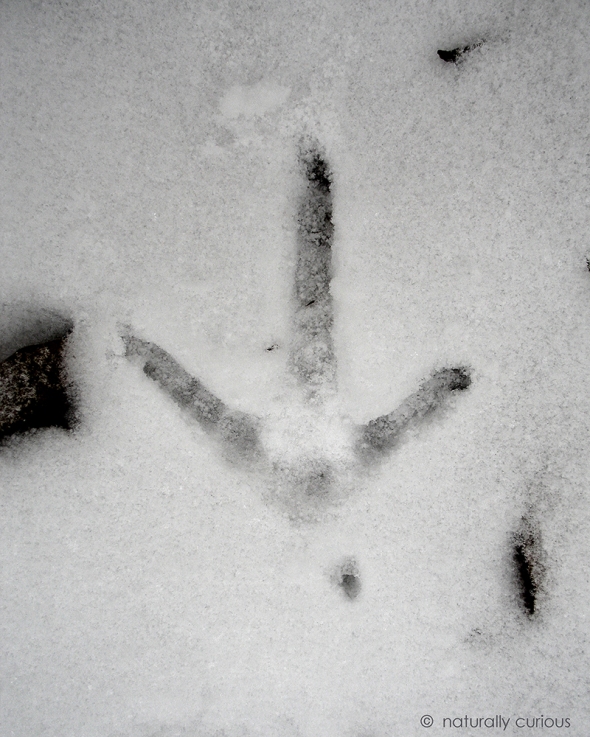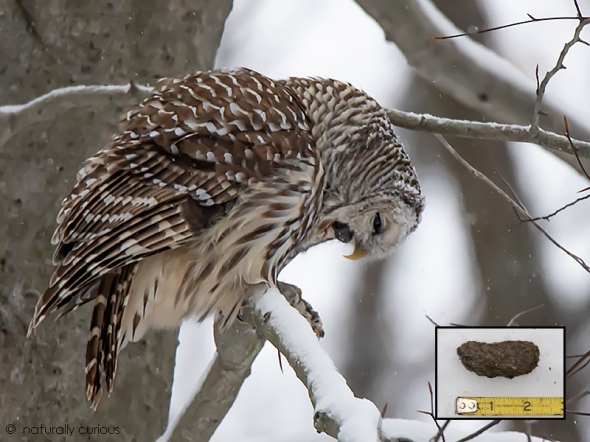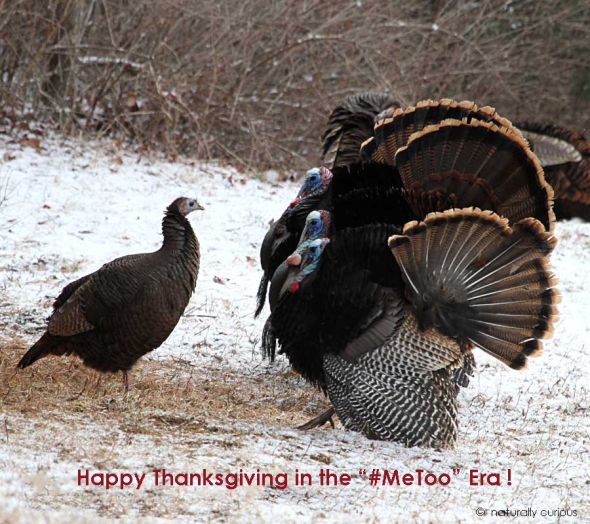Promethea Moth Cocoons

At this time of year, most deciduous trees have lost their leaves. Bare branches make looking for cocoons and finding them much easier. A single leaf dangling from an otherwise barren branch of a tree might very well turn out to be the winter domicile of a Promethea Moth (Callosamia promethea) pupa.
These giant silk moths construct their protective two-inch-long silken cocoons while still in their larval/caterpillar stage. First silk is spun around the stem of the leaf (petiole) as well as where the petiole attaches to the branch, in order to reinforce the attachment of the leaf to the tree. The cocoon is then spun, with the leaf serving as its outer covering. The result is a perfectly disguised shelter that looks like a dead leaf hanging from a branch.
The caterpillar pupates after completing the cocoon. After spending the winter in the pupal stage, the adult moth will emerge in early summer through a valve-like opening at the upper end of the cocoon.
Naturally Curious is supported by donations. If you choose to contribute, you may go to https://naturallycuriouswithmaryholland.wordpress.com and click on the yellow “donate” button.
Bothersome Ads

I apologize for no post today. Central Vermont had a wet and heavy snow storm and the power went out for two days. I just got it back – regular posts will resume Friday.
It has been brought to my attention that WordPress has added advertisements to my posts for the past several weeks (without my knowledge). This is something a blog writer and their readers must tolerate if one chooses to have the type of WordPress blog that I have. (I am currently looking into different options.) I have no idea what ads are put on my blog, nor do I receive any compensation for having them there. I am sorry you have to put up with them, and I thank you very much for tolerating them. Hopefully I will find an alternative way to bring you Naturally Curious posts minus ads! (Photo: how I amused myself with during the storm.)
Winter Finch Forecast: Finch Irruption This Winter
 Things are looking up for those of us who look forward to winters when boreal finches come south in relatively large numbers in search of food. This is an irruption year for winter finches in the East due to the poor cone and birch seed production in northern Ontario and Quebec. Seed-eating birds such as finches, grosbeaks, redpolls and siskins will be frequenting our feeders.
Things are looking up for those of us who look forward to winters when boreal finches come south in relatively large numbers in search of food. This is an irruption year for winter finches in the East due to the poor cone and birch seed production in northern Ontario and Quebec. Seed-eating birds such as finches, grosbeaks, redpolls and siskins will be frequenting our feeders.
Even at this early date, Evening Grosbeak sightings are up noticeably. Pine Grosbeaks will be taking advantage of good Mountain-ash berry and cone production in New England. Purple Finch numbers should also be healthy this winter. While Red Crossbills sightings may be scarce, White-winged Crossbills sightings may well be up due to the poor cone crops in the eastern boreal forest. Both Common and Hoary Redpolls should be numerous this winter due to poor crops of birch, alder and conifer seeds further north.
In addition to these finches, large numbers of Blue Jays, Red-breasted Nuthatches and Bohemian Waxwings are predicted due to poor nut, conifer seed and berry crops, respectively, further north. (Ron Pittaway’s Winter Finch Forecast, 2018-2019, http://jeaniron.ca/2018/wff18.htm ) (Photo: Common Redpoll)
Naturally Curious is supported by donations. If you choose to contribute, you may go to https://naturallycuriouswithmaryholland.wordpress.com and click on the yellow “donate” button.
Grateful
 Thanksgiving presents us with the opportunity to stop and think about the things in life we’re really grateful for. Today I’m most grateful for and give thanks to all of my supportive NC readers.
Thanksgiving presents us with the opportunity to stop and think about the things in life we’re really grateful for. Today I’m most grateful for and give thanks to all of my supportive NC readers.
Turkey Post
I received an comment from a reader who took offense at my “#MeToo” reference in today’s turkey post and felt it was insensitive to the issue of sexual abuse. I (perhaps mistakenly) associate “#MeToo” with the increasing power of women, not specifically with sexual abuse and my photo was an attempt to humerously reflect this. All I meant to infer with the photograph was the hen turkey’s power to choose between three toms to mate with, instead of vice versa. My apologies to anyone I might have offended.
Fire-colored Beetle Larvae

Peek under the loose bark of rotting logs, both deciduous and coniferous, and you’re bound to find the larva of a beetle known as a Fire-colored Beetle (family Pyrochroidae). Its common name is derived from the Greek word pyros (“fire”) + chroma (“’color”), a reference to the bright color, often red, of the adults of some species. From one to several years are spent in the larval stage. Adults of the Pyrochroinae emerge from late spring to midsummer and are primarily nocturnal.
Many adult Fire-colored Beetles are attracted to cantharidin, a toxic compound produced by Blister Beetles. Males locate a Blister Beetle, climb onto it and lick off the cantharidin that Blister Beetles exude and use the blistering agent to impress a female of their own species. When mating takes place, most of the cantharidin is transferred to the female in the form of a sperm packet. The eggs the female subsequently lays are coated with cantharidin to protect them from being eaten before they hatch. (Bugguide.net)
Naturally Curious is supported by donations. If you choose to contribute, you may go to https://naturallycuriouswithmaryholland.wordpress.com and click on the yellow “donate” button.
Eastern Gray Squirrel Diet Preferences

The diet of Eastern Gray Squirrels is extremely varied. Depending on the season, buds, fruit (such as the pictured crabapples being consumed), maple and oak flowers, berries, seeds, fungi, the inner bark of maple and elm, insects, and young birds are eaten. However, nuts are by far the main component, which is reflected in their distribution; the range of Gray Squirrels coincides strikingly with that of oak and hickory forests. Especially during the colder part of the year, nuts, acorns and maple seeds, or samaras, that they have stored for winter consumption are the mainstay of their diet. (Research shows that Gray Squirrels recover 85% of the nuts they store.)
Naturally Curious is supported by donations. If you choose to contribute, you may go to https://naturallycuriouswithmaryholland.wordpress.com and click on the yellow “donate” button.
Evergreen Orchid Leaves Brighten The Forest Floor
 Downy Rattlesnake Plantain (Goodyera pubescens) is a perennial evergreen orchid found growing in deciduous and coniferous forests, often in dry, sandy soil. While its hairy (downy) stalk of delicate, white, late-summer flowers is eye-catching (see 8/20/13 NC post), the leaves of Downy Rattlesnake Plantain are also works of art. Rosettes of bluish-green leaves emerge at the end of horizonal rhizomes, or stems, that are usually covered lightly by leaf litter.
Downy Rattlesnake Plantain (Goodyera pubescens) is a perennial evergreen orchid found growing in deciduous and coniferous forests, often in dry, sandy soil. While its hairy (downy) stalk of delicate, white, late-summer flowers is eye-catching (see 8/20/13 NC post), the leaves of Downy Rattlesnake Plantain are also works of art. Rosettes of bluish-green leaves emerge at the end of horizonal rhizomes, or stems, that are usually covered lightly by leaf litter.
The common name “plantain” has been applied to diverse, unrelated plants that have broad, flat leaves, the word being derived from the Latin word planta, referring to the sole of the foot. “Rattlesnake” alludes to the resemblance of this plant’s prominent reticulated veins to the scaly skin of snakes.
As is typical of orchids, the roots of Downy Rattlesnake Plantain have a mycorrhizal relationship with fungi that assists the plant in the acquisition of moisture and nutrients, while the plant provides products of its photosynthesis to feed the fungus. Also typical of orchids, the seeds of this species are minute and dust-like, bearing few nutrients to assist in the establishment of new seedlings. Seedling establishment requires assistance from soil fungi, from which the orchid derives the organic molecules it needs until it can make its own food via photosynthesis in its leaves.
Naturally Curious is supported by donations. If you choose to contribute, you may go to https://naturallycuriouswithmaryholland.wordpress.com and click on the yellow “donate” button.
Lingering Great Blue Herons

Most fish-eating birds that breed where most bodies of water freeze over in the winter migrate further south in the fall, including Great Blue Herons. Movement of this large wading bird takes place largely from September to mid-October. According to Christmas Bird Count data, the Great Blue Heron has the widest wintering distribution of any heron species in North America.
While the number of Great Blue Herons in the Northeast is greatly diminished in November and December, it’s not uncommon to spot lingering birds at this time of year. Come January, when most bodies of fresh water are inaccessible to herons, sightings become rare until they begin returning in March.
Where open water remains in the Northeast, those Great Blue Herons braving the cold continue to consume fish, insects, amphibians and crustaceans. Small mammals, especially voles, and birds remain a warm-month delicacy, when mammal hair is cast in pellets and bones are digested.
Naturally Curious is supported by donations. If you choose to contribute, you may go to https://naturallycuriouswithmaryholland.wordpress.com and click on the yellow “donate” button.
Red Squirrels Caching Food For Winter

Both carnivores and herbivores cache, or store, food for later consumption. Black-capped Chickadees tuck seeds into bark crevices. Bobcats may cover their kills with leaves, grass, snow and even hair from their prey’s carcass. Grey Squirrels bury their nuts individually, while Red Squirrels often hide green cones in a pile of cone scales (middens) that accumulate at the site where the squirrels have previously eaten seeds, keeping the young cones moist so that they will retain the seeds within them.
Red Squirrels sometimes go one step further than most animals that cache food — they frequently preserve their food by drying it before storing it. You’ll recognize this when you see it – an apple or mushroom stuck in the crotch of two branches. Sometimes the dried food is collected and cached near their winter quarters, but often it remains lodged in tree branches until eaten. The pictured mushroom, which was hung out to dry, was reduced almost to mush by the torrential rains we’ve had lately. Eventually it will dry out and remain edible into the winter.
Naturally Curious is supported by donations. If you choose to contribute, you may go to https://naturallycuriouswithmaryholland.wordpress.com and click on the yellow “donate” button.
Next Year’s Buds Already Formed
 Because tree buds tend to swell and increase greatly in size in the spring, this is often the season when we first notice them and assume that this is when they are produced. However, if you look in the axils of leaves on any deciduous tree right now, you will see full-size buds that were formed this summer. These little packages of miniature leaves, branches and sometimes flowers, will remain on trees all winter, tightly closed and often protected from the elements by modified leaves called bud scales. Come spring, when trees are once again taking up quantities of water, their buds will swell, scales will fall off (leaving bud scale scars), and tiny, pristine leaves or flowers will appear. (Photo is of American beech, Fagus grandifolia, bud.)
Because tree buds tend to swell and increase greatly in size in the spring, this is often the season when we first notice them and assume that this is when they are produced. However, if you look in the axils of leaves on any deciduous tree right now, you will see full-size buds that were formed this summer. These little packages of miniature leaves, branches and sometimes flowers, will remain on trees all winter, tightly closed and often protected from the elements by modified leaves called bud scales. Come spring, when trees are once again taking up quantities of water, their buds will swell, scales will fall off (leaving bud scale scars), and tiny, pristine leaves or flowers will appear. (Photo is of American beech, Fagus grandifolia, bud.)
Just a quick reminder that the NC Calendar ordering deadline is November 10th.
Naturally Curious is supported by donations. If you choose to contribute, you may go to https://naturallycuriouswithmaryholland.wordpress.com and click on the yellow “donate” button.
Fermenting Apples & Black Bears ≠ Inebriation
 If you investigate the contents of Black Bear scat this time of year, you may well find nothing but chunks of digested and semi-digested apple (pictured). For several weeks before hibernation begins bears spend their days and nights foraging for food that will sustain them through the coming months (“hyperphagia”). Fermenting apples lying on the ground are accessible and very popular with bears; hence, many scats contain them.
If you investigate the contents of Black Bear scat this time of year, you may well find nothing but chunks of digested and semi-digested apple (pictured). For several weeks before hibernation begins bears spend their days and nights foraging for food that will sustain them through the coming months (“hyperphagia”). Fermenting apples lying on the ground are accessible and very popular with bears; hence, many scats contain them.
There have been anecdotal reports over the years of Black Bears stumbling around as if inebriated, and it is often assumed that this behavior is the result of their having consumed fermenting fruit, such as apples. Waxwings, robins and other species of birds are known to get drunk (and even die) from fermented crab apples, mountain ash and blackberries, but it’s highly unlikely that bears follow suit.
For one thing, the pH of a bear’s stomach is around 3.5 – slightly more acidic than yeast can tolerate. In addition, the time it takes for a Black Bear to digest food is typically far less time than yeast would need to convert sugar into alcohol. Lastly, size would play a large role in an animal’s ability to become intoxicated. It would take hundreds of apples consumed at their peak level of fermentation to make even a small, young Black Bear even slightly tipsy.
If you see a Black Bear stumbling and acting strange it may well be because it is sleepy or perhaps sick, but probably not drunk. However, until researchers test the blood alcohol level of a bear that’s exhibited this behavior, no–one can say for sure what caused it.
Naturally Curious is supported by donations. If you choose to contribute, you may go to https://naturallycuriouswithmaryholland.wordpress.com and click on the yellow “donate” button.
 Most owls do not bother to tear small prey such as mice and voles apart but instead swallow them whole. After eight to sixteen hours, all the nutrients available in the eaten prey have been absorbed by the bird. Owls cannot digest the fur, feathers, bones, teeth and nails of their prey, so these parts remain in the bird’s gizzard (specialized organ that grinds up food in most birds but serves as a filter for holding indigestible parts in birds of prey). This accumulation of indigestible parts takes on its pellet form (which is the shape of the gizzard) about eight hours after ingestion, but is sometimes retained by the owl for another six hours or so before being coughed up. As a rule, bones are on the inside of the pellet, and the fur and feathers form a soft coating on the outside.
Most owls do not bother to tear small prey such as mice and voles apart but instead swallow them whole. After eight to sixteen hours, all the nutrients available in the eaten prey have been absorbed by the bird. Owls cannot digest the fur, feathers, bones, teeth and nails of their prey, so these parts remain in the bird’s gizzard (specialized organ that grinds up food in most birds but serves as a filter for holding indigestible parts in birds of prey). This accumulation of indigestible parts takes on its pellet form (which is the shape of the gizzard) about eight hours after ingestion, but is sometimes retained by the owl for another six hours or so before being coughed up. As a rule, bones are on the inside of the pellet, and the fur and feathers form a soft coating on the outside.
 A discovery recently brought to my attention has stumped this naturalist. What you are looking at is a collection of Flying Squirrel tails lying within a 30-square-foot patch of ground adjacent to a stand of Eastern Hemlocks. For several days in succession, additional tails appeared each morning, eventually totaling 20 or more.
A discovery recently brought to my attention has stumped this naturalist. What you are looking at is a collection of Flying Squirrel tails lying within a 30-square-foot patch of ground adjacent to a stand of Eastern Hemlocks. For several days in succession, additional tails appeared each morning, eventually totaling 20 or more.

















What Other Naturally Curious People Are Saying